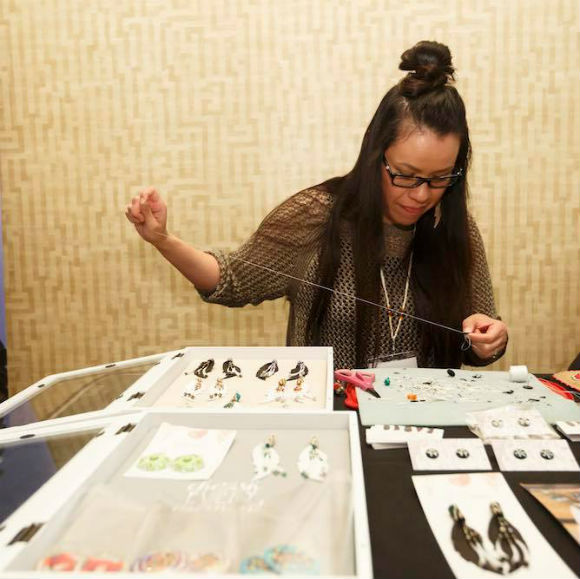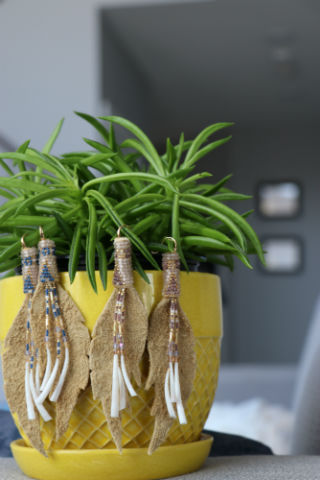
Jessica Sanderson-Barry working on designs for JShine Designs
An avid beader, Jessica Sanderson-Barry had hoped to turn her passion into a business opportunity, but found she never had much success making a living off her work.
"I was beading flat back pieces, and I found that it was really hard to position myself as a business and be successful because this style of beading was so readily available. So I got to thinking, 'ok this is not working for me, maybe I need to find my own way and create some unique pieces,'" she said.
Setting out to find her own way, Sanderson-Barry enrolled in the Faculty of Native Studies and, in 2017, was one of 14 students accepted into the Wahkohtowin summer intensive land-based course offered jointly by the faculties of Native Studies and Law.
"It was my first time taking a land-based course and I learned so many different things. It was just awesome, [learning from] the knowledge keepers in Susa Creek," Sanderson-Barry said.
The course was structured around the traditional tanning of a moose hide, and at the end of the course, each student was gifted two pieces of the hide they tanned. Sanderson-Barry knew she needed to do something special with the pieces she received.
"Those [pieces] meant a lot to me, because I knew how much work went into that hide, it was very precious," she said.
Going back to the design phase of her beading, she came up with something unique, her now-signature feather design. Out of that cherished hide she created two pairs of beaded earrings, for herself and her daughter. The positive feedback and response to her designs inspired her to keep at it, and she created a collection of 30 pieces to sell at a market.
When that collection sold out, she said, she realised she had a creative business opportunity.
From there, and learning as she went, Sanderson-Barry registered her business and developed her own website: JShine Designs.
"Establishing and registering my business was a major step to be taken seriously. I'm not just a beader. I'm an artist, I'm a designer, I create beautiful beadwork, it's not just beads, it's beyond the beads."
The hard work of learning the business end of things was challenging, but worthwhile. With her business established, her designs were in demand. In 2018 she was commissioned to bead the logo for the City of Edmonton's Indigenous Artist-in-Residence Program.
"I can only make what I have time for, because there's a lot of energy that goes into each piece and I want to make sure it's created with good intentions and perfect."
The intentions and energy behind her creations are an important part of her work she said, in part because she's seen so much mass produced culturally appropriated art being sold at markets.
"Indigenous art is shifting and I feel like I want to make sure I'm creating something people know is not manufactured, they're purchasing an authentic piece of art."

Connection
Beading for Sanderson-Barry is about more than just the work. It's about the community. Some of those connections are formed face to face, but many are formed over social media. She said social media has enabled her to connect with other artists, with whom she's formed a network that enables them to share knowledge, challenges, techniques, and accomplishments.
"Social media has played an important role in my business. When other artists support my work, and I support theirs, that brings this whole community together, and I think if we do more of that uplifting we rise together," she said.
Connection has always been an important part of beading for Sanderson-Barry.
"My great-grandmother, Jenny Lightning from Samson Cree Nation, was a phenomenal beader. I didn't have a chance to meet her, but I feel like [beading] is my connection to her, it's in my blood line."
The familial connection doesn't only reach backwards, Sanderson-Barry said.
"My mother and my grandmother both don't bead, so it's a revitalization of those cultural practices. I have other family members who want to learn how," she said. "So it's transmitting that knowledge and keeping that within our kin and keeping it alive."

Education
It was back in 2014, as the Truth and Reconciliation Commission (TRC) was documenting the truth of survivors of Indian Residential Schools (IRS) and informing Canadians about what happened, that Sanderson-Barry attended a TRC event in Edmonton.
"I attended a TRC conference with my mooshum, and IRS was never talked about within my family. I began to understand the intergenerational trauma within my family kin," she said. "Knowing the pain and trauma my grandmothers and mooshums have gone through ignited a fire under me, I wanted to understand more of Indigenous history," she said.
Sanderson-Barry's late grandmother Clara Sanderson-Godin, a residential school survivor, was eligible for personal credits for educational purposes, but uninterested in going back to school at age 70. So Sanderson-Barry approached her with a proposition.
"I was like, 'I have this opportunity to go to university in the Faculty of Native Studies, I can take Cree and all these courses'," she said. "'Do you mind if I use that transfer credit and go back to school.' And she really encouraged me and was always supportive in my education journey. And that paid for my first 2 semesters."
Even though Sanderson-Barry had already achieved a diploma in accounting and a Bachelor of Administration degree from NAIT, she still felt out of place at university.
"I really thought that I wasn't supposed to be here. No one talked to me about attending university. But creator had a different plan for me," she said.
Jessica convocated on June 4th from the Bachelor of Arts in Native Studies and a Aboriginal Governance and Partnership Certificate.
"This date was significant and very emotional, as it was four years since my grandmother Clara left to the spirit world, and all I could think was I would not be standing here without her. As I walked across the stage receiving my degree, I remembered the path she walked and how resilient she was overcoming everything that stood in her way. I shared that day with her," she said.
At one time, Sanderson-Barry saw achieving her BA in Native Studies as the end of her educational journey. Now, she's considering other opportunities for her future.
"After seeing Tara Kappo's thesis and the way she was able to use her beadwork, to know that anything is possible inspires me to consider my MA. But for now I'm focusing on my business, getting my brand out there, and maybe collaborating with other Indigenous artists."
"I just take it day by day, bead by bead."